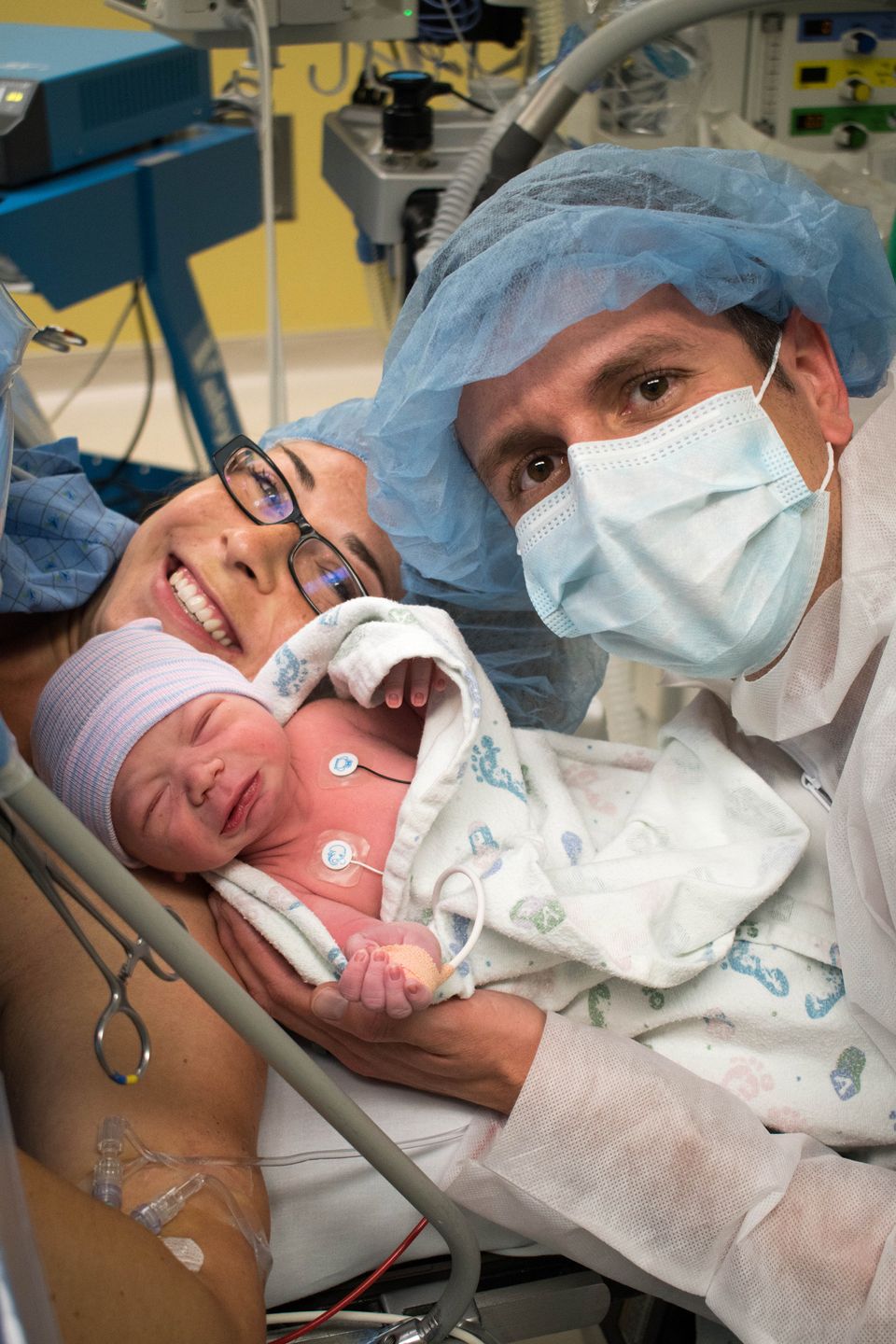A C-SECTION is an operation, a surgical incision to the abdomen and uterus that is performed if a vaginal delivery puts the mother or baby at risk. Today, in the United States, 1 in 3 women have a Cesarean birth. What most of us don't know is that there are three types of C-Sections. Emergency, Unscheduled and Scheduled.
Emergency C-Section
In an emergency, a C-Section is life saving for the mother, infant or both. The baby can be extracted in a matter of minutes, and written consent is not legally required. Some of the main reasons for an emergency C-Section are:
- Prolapsed umbilical cord - umbilical cord is born before the baby.
- Maternal hemorrhage
- Placenta abruption (when the placenta peels away from the wall of your uterus)
- Uterine rupture (when your uterus tears along a previous C-section scar)
Unscheduled C-Section
Unplanned cesareans are still urgent, but typically the mother and baby aren’t in life-threatening situations. Some common causes for an unplanned C-section are Failure to Progress, Fetal Tracing or Malpresentation. In birth, there are three physiological changes that are essential: cervical change, hormones cause uterine contractions and correct babies position. The three most common causes of a C-section directly correlate. My own C-Section occurred because my baby was in the OP or Occiput Posterior position (sunny side up).
Labor isn’t progressing
The main tool that is used to indicate labor progression is Friedman's curve. Friedman’s curve was developed in 1955 and describes the average amount of time for cervical dilation. The study concluded that the average dilation was 14 hours to go from 0-10 cm. In his study, 500 caucasian patients at a single hospital were studied, 96% of the women were sedated with demerol and scopolamine. In 2014 ACOG encouraged providers not to use these numbers to adequately recommend a C-Section if the reason is Failure to Progress. As we understand more about the stages of labor, it's easy to see how this rate of progression was affected by the medicated state of the laborers.
In 2010, Zhang studied 62,000 women from 19 hospitals and found an average of 21 hours. His findings found that after active labor - or when 6 cm dilated was achieved, the average rate of progression was 90 minutes for each cm of dilation. Before 6 cm, women went long periods without any dilation, even up to 8 hrs to progress 1 cm. In this same study, he found for a woman to progress from 4-5 cm took 7 hours. These women had healthy vaginal deliveries.
Ida May, a lifelong Midwife indicated, through her midwife experience, that a typical labor for a unmedicated woman was 21 hours.
In my own experience, my first labor was classified as failure to progress at 40 hrs and dilated to 2 cm: C-Section, 28 hrs for my second unmedicated VBAC delivery, and 9 hours for my third unmedicated VBAC delivery.
Contractions are too weak
If contractions are too weak, it could be due to uterine dysfunction. In prolonged labor, more attention is usually paid to the fetus and pelvis rather than to the role of uterine contractions. If one is in active labor, she could change positions, use a birthing ball, take a warm shower or bath, walk, breathe, or have a massage to strengthen contractions.
Baby isn’t tolerating labor
A slow heart rate, or unusual patterns in the heart rate, may signal fetal distress. If Pitocin is augmented, the baby may not be tolerating the external stress. Pitocin could be halted to allow for the baby to reset.
Baby Position
Ideally for labor, the baby is positioned head-down, facing the mother's back with the chin tucked to its chest and the back of the head ready to enter the pelvis. This position is called cephalic presentation. Most babies settle into this position within the 32nd to 36th weeks of pregnancy. If the baby is not in this position, Spinning Babies or Webster Certified Chiropractic care is recommended.
Breech
If your baby is breech, they are not head down by 34 or 35 weeks, and have not rotated, manual rotation or external cephalic version (ECV) can be attempted. Even in the case of Breech presentation, ACOG states, births can be attempted vaginally with the properly trained physician. “In a breech presentation, the body comes out first, leaving the baby’s head to be delivered last. The baby’s body may not stretch the cervix enough to allow room for the baby’s head to come out easily. There is a risk that the baby’s head or shoulders may become wedged against the bones of the mother’s pelvis.”
If a C-Section is not an emergency, a patient can request more time, and discuss all options with a provider to be certain that the most informed care is provided and informed consent is respected.
Scheduled C-Section
If there’s a medical indication that a vaginal delivery will not be successful, a scheduled C-Section may be safest. These include:
- Placenta Previa: a low-lying placenta partially or completely covers the cervix.
- Cephalopelvic disproportion (CPD): the mothers pelvis is too small, or the baby’s head is too large for the birth canal.
- Health Condition: heart disease, high blood pressure, gestational diabetes may prohibit a mother from delivering vaginally.
- STD’s: If the birthing person has HIV, genital herpes or other transmissible disease. HELLP (Hemolysis, Elevated Liver enzymes and Low Platelets) a life threatening complication: breaking down of red blood cells, elevated liver enzymes and low platelet count manifested by high blood pressure, nausea, swelling.
In all three types of C-Sections, the health of the mother and baby during delivery and thereafter are paramount. As we are more aware of C-Sections we can provide the needed education to prevent unnecessary C-Sections and support to those who undergo surgery in the postpartum period.
Article by Sarah Ziroll

Sarah’s greatest joy is her family: her husband and boys. In her free time, she loves escaping in a great book, “Sarahnading” on her violin, singing, creating crafts and diy projects, hiking the gorgeous mountains of Utah and skiing. Sarah is a Birth Coach and Certified Birth Doula. She’s had 3 amazing births and is passionate to help you achieve the birth of your dreams.


